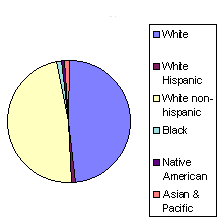By Dan Gunderson
May 3, 1999
|
|
RealAudio 3.0 |
The picture of rural Minnesota painted by official government statistics shows a
white tapestry with occasional scattered threads of color. But some would argue
that picture is inaccurate. In the past 150 years, immigrants from
more than 60 countries came to Minnesota, creating a state which may seem
homogeneous, but enjoys a legacy of rich cultural diversity.
THE MINNESOTA OF RECORDED HISTORY
was first populated several hundred years ago
by Dakota and Ojibwe Indians. In the early 1800s, a trickle of European
immigrants began to arrive; most were French Canadians who established a fur
trade. The first sizable white settlement wave came in the mid 1800s when
thousands of Yankees arrived looking to create a New England of the west.
The immigrants who would have the greatest role in shaping Minnesota
began arriving soon after. Germans, Swedes and Norwegians have dominated the
population of Minnesota since 1880.
They came looking for a better life. Often they were not greeted with open arms.
The Minnesota Historical Society's Deborah Miller says when Scandinavians
arrived in Minnesota in the mid 1800s, they were treated with derision by the
resident Yankees.
Miller: Scandinavians were considered , I think the insulting term was "squarehead. " People weren't necessarily interested in each other's culture and learning about each other. There was rivalry. There was conflict.
 |
| The Face of Minnesota 1997 Ethnic make-up of the population (Source: U.S. Census) |
Germand: Here moves in a whole bunch of Germans and the American citizens that lived there were kind of put out by that. They could see what was happening. The whole country was being taken over by these Germans. And so it was kind of a hostile situation always.Within a few years, intermarriage blurred the lines between the largest ethnic groups. But the Historical Society's Deborah Miller says those early immigrant groups maintain a strong influence in areas of the state where they settled. For example, German culture dominates parts of central Minnesota. Scandinavian heritage left an obvious imprint on the Red River Valley.
The turn of the century brought the largest wave of immigrants to Minnesota. But another significant - but much smaller - wave has arrived in the past 20 years. These immigrants include Hispanics, Somalis, Kurds, Bosnians and Southeast Asians.
It's hard to fix numbers to the most recent immigrant arrivals. Official statistics show about 51,000 overseas immigrants came to Minnesota in the past 20 years. But others say the actual number may be well over 100,000. A clearer picture of new immigrants should come out of the census that will be taken next year.
| More Information |
The patterns of immigration to Minnesota have changed over the years. See a chartof immigration by ethnic groups.
|
But some common threads connect the recent arrivals to the turn-of-the-century immigrants. Nearly all came to escape oppressive poverty or war. Most have faced some degree of hostility from those who came before.
The State Historical Society's Deborah Miller says it's an interesting historical irony that many descendants of the early European immigrants struggle to accept contemporary immigrants.
Miller: The same folks whose English may be a little bit ragged right now. Your grandmother or great grandmother was in exactly the same position 75 or 100 years ago. So I think the more people can think about their family's commonalties with more recent immigrants, probably the more successful a state Minnesota will be.The upheaval felt by immigrants across Minnesota history is remarkably similar as they struggle to comprehend a new language and culture.
Andrew Lindgren came from Sweden to Minnesota in 1914. In a 1978 interview with a historian, he recalled the overwhelming experience of stepping off the train alone, in a strange place.
Lindgren: I have no place to go when I get there, and I couldn't speak English. So I stood there at the station, and I didn't know what to think.Marissa Hajdar felt the same confusion when she arrived from Bosnia four years ago.
Hajdar: People is different. Rules is different. Everything. We just come here and we don't know anything.Marissa says many people have befriended her and her family since they came to Minnesota. But she's detected a clear message: If you want to be accepted, you must work hard and not cause trouble. It's the classic melting-pot idea long the backbone of U.S. immigrant assimilation. It's less fashionable amongst academics, and strongly resisted in some long-established immigrant groups, but still very real in many communities.
And Marissa says Americans too often ignore the individuality of new immigrants.
Hajdar: Somebody say everybody same. Is not same. We are Bosnia people. Not same. Every people different.
| More Information |
Hear an extended interview with Joe Amato, Dean of Rural and Regional Studies at Southwest State University in Marshall. (10:36)
|
Amato: Race doesn't make people eat the same foods. Race doesn't make them speak the same language. Race doesn't teach them to dance. Race doesn't make them ambitious or not.Amato says by conventional measure, rural Minnesota is devoid of diversity. Census statistics show less than five percent of the population is considered diverse. Amato thinks those simplistic definitions only serve to keep people apart.
Amato: If we get locked in generalizations like we're all white farmers experiencing "x," or we're all small town people doing this, we become pawns of the kind of books like Sinclair Lewis' Main Street and we become pawns of stereotypes. My position is to always to try to create diversity in what I consider to be the true and rich sense of the word; we recognize ranges of cultures, ranges or classes, ranges of different human experience and human aspirations.Joe Amato contends the tendency toward simplistic categorization of people means the people of Minnesota have forgotten where they came from and don't know who they are.
